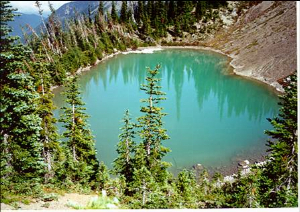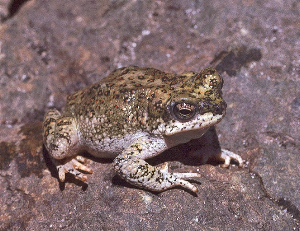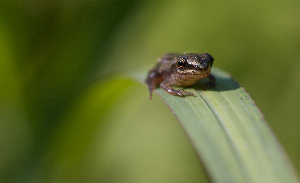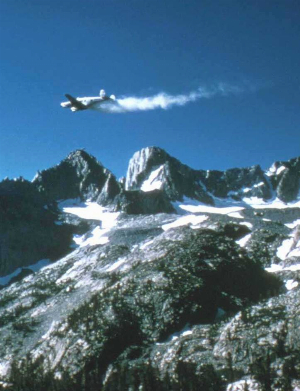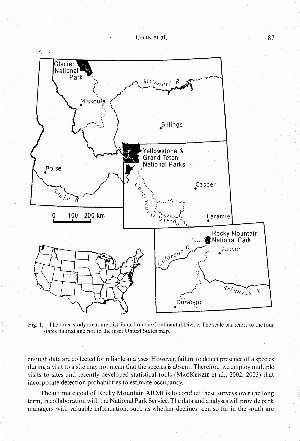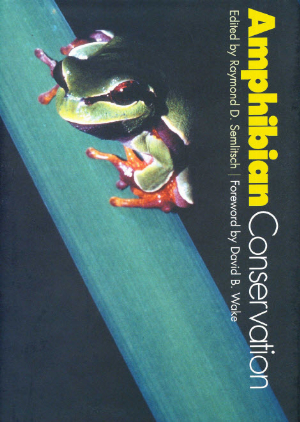Search ARMI Database
Search term(s)
Contribution Number
Search Results
879 record(s) found.
Papers & Reports Establishing a baseline and faunal history in amphibian monitoring programs: the amphibians of Harris Neck, Georgia, USA
Authors: Kenneth C Dodd; William J Barichivich
Date: 2007 | Outlet: Southeastern Naturalist 6: 125-134
We conducted an intensive inventory of Harris Neck National Wildlife Refuge in coastal Georgia to determine the feasibility of establishing an amphibian monitoring program at this location. Thirteen semi-aquatic amphibian species were identified at 21 locations. Amphibian species richness at Harris Neck was similar to that of nearby barrier islands. The amphibian fauna of Harris Neck has long been affected by human-induced landscape changes, including the inadvertent introduction of tadpoles from distant fish hatcheries and the creation of artificial impoundments. Land-use history provides important information necessary to understand current amphibian distribution, especially when census data are used to establish a baseline from which to monitor future status and trends.
Papers & Reports Diversity and similarity
Authors: Kenneth C Dodd
Date: 2009 | Outlet: Dodd CK Jr, editor. Amphibian ecology and conservation, a handbook of techniques. Oxford University Press 321-337
Book chapter
Papers & Reports Population manipulations
Authors: Kenneth C Dodd
Date: 2005 | Outlet: Lannoo M, editor. Amphibian declines: the conservation status of United States species. Berkeley: University of California Press 265-270
Book chapter
Papers & Reports Phaeognathus hubrichti Highton, 1961, Red Hills Salamander
Authors: Kenneth C Dodd
Date: 2005 | Outlet: Lannoo M, editor. Amphibian declines: the conservation status of United States species. Berkeley: University of California Press 785-787
Species account
Papers & Reports The amphibians of Great Smoky Mountains National Park
Authors: Kenneth C Dodd
Date: 2004 | Outlet: Knoxville: University of Tennessee Press 1-283
Book
Papers & Reports Monitoring amphibians in Great Smoky Mountains National Park
Authors: Kenneth C Dodd
Date: 2003 | Outlet: U.S. Geological Survey Circular 1258 117
Monitoring manual
Papers & Reports Review of Reptiles and Amphibians of the Smokies, by S.G. Tilley and J.E. Huheey, 2001
Authors: Kenneth C Dodd
Date: 2002 | Outlet: Herpetological Review 33: 76-77
Book review
Papers & Reports A landmark publication on the amphibians of northern Eurasia
Authors: Kenneth C Dodd
Date: 2000 | Outlet: Alytes 18: 91-94
Book review
Papers & Reports Estimated ultraviolet radiation doses in wetlands in six national parks
Authors: S Diamond; P Trenham; Michael J Adams; Blake R Hossack; Roland A Knapp; S L Stark; David F Bradford; P. Stephen Corn; K Czarnowski; Paul D Brooks; D Fagre; Bob Breen; N E Detenbeck; K A Tonnessen
Date: 2005-07-31 | Outlet: Ecosystems 8: 462–477
Ultraviolet-B radiation (UV-B, 280 nm to 320 nm wavelengths) doses were estimated for 1024 wetlands in six National Parks; Acadia (Acadia), Glacier (Glacier), Great Smoky Mountains (Smoky), Olympic (Olympic), Rocky Mountain (Rocky), and Sequoia/Kings Canyon (Sequoia/Kings). Estimates were made using ground-based UV-B data (Brewer spectrophotometers), solar radiation models, GIS tools, field characterization of vegetative features, and quantification of DOC concentration and spectral absorbance. UV-B dose estimates were made for the summer solstice, at a depth of 1 cm in each wetland. Mean dose across all wetlands and parks was 19.3 Whr*m-2 (range of 3.4 to 32.1 Whr*m-2). Mean dose was lowest in Acadia (13.7 Whr*m-2) and highest in Rocky (24.4 Whr*m-2). Doses were significantly different among all parks. These wetland doses correspond to UV-B flux of 125.0 W*cm-2 (range of 21.4 to 194.7 W*cm-2) based on a day length, averaged among all parks, of 15.5 hr. Dissolved organic carbon (DOC), a key determinant of subsurface UV-B flux, ranged from 0.6 (analytical detection limit) to 36.7 mg carbon * l-1 over all wetlands and parks, and reduced potential maximal UV-B doses at 1 cm depth by 1 to 87 %. DOC concentration, as well as its effect on dose, was lowest in Sequoia/Kings, and highest in Acadia (DOC was equivalent in Acadia, Glacier, and Rocky). Landscape reduction of potential maximal UV-B doses ranged from zero to 77 %, and was lowest in Sequoia/Kings. These regional differences in UV-B wetland dose illustrate the importance of considering all aspects of exposure in evaluating the potential impact of UV-B on aquatic organisms.
Papers & Reports Large-scale habitat associations of four desert anurans in Big Bend National Park, Texas.
Authors: G H Dayton; R E Jung; S Droege
Date: 2005 | Outlet: Journal of Herpetology 38: 619-627
Papers & Reports Bufo canorus Camp 1916, Yosemite Toad
Authors: C Davidson; Gary M Fellers
Date: 2005 | Outlet: Lannoo M, editor. Amphibian declines: the conservation status of United States species. Berkeley: University of California Press 400-401
Papers & Reports Fluctuations in a metapopulation of nesting Four-toed Salamanders, Hemidactylium scutatum, in the Great Smoky Mountains National Park, USA, 1999-2003
Authors: J D Corser; Kenneth C Dodd
Date: 2004 | Outlet: Natural Areas Journal 24: 135-140
We tested two predictions associated with the hypothesis that certain populations of pond-breeding amphibians are structured into metapopulations using minimum relative abundance estimates of nesting four-toed salamanders (Hemidactylium scutatum Schlegel) from 11 different ponds in the Great Smoky Mountains National Park. Coefficients of variation (CV) for counts at individual ponds ranged from https://0.25 to https://1.26, and the overall mean CV at all 11 ponds was https://0.34. Many pairs of ponds had negative correlations in abundance from 1999-2003, whereas others had various degrees of positive correlation (mean r = 0.29). Thus, nesting population size fluctuated semi-independently among the ponds from year to year, inferring the existence of inter-pond dispersal. The mean number of nesting females at a pond was negatively, but non-significantly, correlated (r = -https://0.27; P = https://0.40; 10 d.f.) to the pond's isolation. Owing to physiological constraints on plethodontid salamander energetics, precipitation during the nesting season (February and March) appeared to play an important role (r = https://0.78; P = https://0.12; 4 d.f.) in the number of nesting females we observed. Unlike some other plethodontid salamander populations in more fragmented southern Appalachian forest ecosystems, this (meta)population within Great Smoky Mountains National Park does not appear to be declining.
Papers & Reports Decline of disjunct green salamander populations (Aneides aeneus) in the southern Appalachians
Authors: J D Corser
Date: 2001 | Outlet: Biological Conservation 97: 119-126
Papers & Reports A comparison in Colorado of three methods to monitor breeding amphibians
Authors: P. Stephen Corn; Erin Muths; W M Iko
Date: 2000 | Outlet: Northwestern Naturalist 81: 22–30.
We surveyed amphibians at 4 montane and 2 plains lentic sites in northern Colorado using 3 techniques: standardized call surveys, automated recording devices (frog-loggers), and intensive surveys including capture-recapture techniques. Amphibians were observed at 5 sites. Species richness varied from 0 to 4 species at each site. Richness scores, the sums of species richness among sites, were similar among methods: 8 for call surveys, 10 for frog-loggers, and 11 for intensive surveys (9 if the non-vocal salamander Ambystoma tigrinum is excluded). The frog-logger at 1 site recorded Spea bombifrons which was not active during the times when call and intensive surveys were conducted. Relative abundance scores from call surveys failed to reflect a relatively large population of Bufo woodhousii at 1 site and only weakly differentiated among different-sized populations of Pseudacris maculata at 3 other sites. For extensive applications, call surveys have the lowest costs and fewest requirements for highly trained personnel. However, for a variety of reasons, call surveys cannot be used with equal effectiveness in all parts of North America.
Papers & Reports The U. S. Geological Survey’s Amphibian Research and Monitoring Initiative
Authors: P. Stephen Corn; Erin Muths; Michael J Adams; Kenneth C Dodd
Date: 2005 | Outlet: Alytes 22: 65–71
The Amphibian Research and Monitoring Initiative (ARMI) began in 2000 as an attempt by the United States Geological Survey to determine the status and trends of amphibians on federal lands in the United States and its territories. ARMI research focuses on determining causes of declines, if observed, developing new techniques to sample populations and analyze data, and disseminating information to scientists and policy makers. Monitoring is conducted at multiple scales, with an emphasis on an ability to draw conclusions about status in well-defined study areas such as national parks and wildlife refuges. Several papers originally presented at a national symposium in 2004 are published in this special issue of Alytes.
Papers & Reports Variable breeding phenology affects the exposure of amphibian embryos to ultraviolet radiation: reply
Authors: P. Stephen Corn; Erin Muths
Date: 2004 | Outlet: Ecology 85: 1759–1763
Corn and Muths (2002) described how seasonal and annual variation in estimated flux of ultraviolet-B (UVB)radiation, combined with year-to-year variation in amphibian breeding phenology, introduces considerable variability in the UV-B exposures to amphibians. The response to our paper by Blaustein et al. (2004)misstates the objectives and conclusions of our study, contains other errors of interpretation, and critiques our study for adopting practices that they themselves use. We are confident that an unbiased assessment will show that the conclusions of Corn and Muths (2002) are valid and robust with respect to montane amphibians, and that the criticisms raised by Blaustein et al. (2004) are either invalid or irrelevant.
Papers & Reports Variable breeding phenology affects the exposure of amphibian embryos to ultraviolet radiation
Authors: P. Stephen Corn; Erin Muths
Date: 2002 | Outlet: Ecology 83: 2958–2963
Reduced water depth in dry years has been proposed to interact with ultraviolet-B (UV-B) radiation and a pathogenic fungus to cause episodes of high mortality of amphibian embryos. Observations of breeding phenology of boreal chorus frogs (Pseudacris maculata) in Colorado from 1986 to 2001 show that dry years result in earlier breeding. The earliest and latest dates of maximum calling activity by males were 20 May and 16 June, and the date of maximum calling was strongly related to the amount of snow accumulation during the winter. Surface UV-B flux, estimated from satellite-based measurements, was positively related to date of maximum calling. In dry years, surface UV-B during calling was reduced by an amount similar to that attributed to reduced depth. Although there was a significant trend of increasing UV-B from 1978 to 2001 on the average date (2 June) of maximum calling activity, there was no relationship between year and surface UV-B at actual dates of maximum calling. Exposure to extreme temperatures is an alternative explanation for increased mortality of amphibian embryos in shallow water.
Papers & Reports Fish Stocking in protected areas: summary of a workshop
Authors: P. Stephen Corn; Roland A Knapp
Date: 2000 | Outlet: Cole DN, McCool SF, Borrie WT, O’Loughlin J, compilers. Wilderness science in a time of change conference—Volume 5: Wilderness ecosystems, threats, and management. Ogden, UT: U.S. Department of Agric
Native and nonnative sport fish have been introduced into the majority of historically fishless lakes in wilderness, generating conflicts between managing wilderness as natural ecosystems and providing opportunities for recreation. Managers faced with controversial and difficult decisions about how to manage wilderness lakes may not always have ready access to research relevant to these decisions. To address this problem, and to expose scientists to the concerns and constraints of managers and wilderness users, a workshop was held in October 1998 at the Flathead Lake Biological Station in Polson, Montana. Participants included 43 scientists, state and federal managers, wilderness users and advocates and students. Four subject areas were addressed: federal, state, tribal and user perspectives, community and ecosystem effects, species effects and management recommendations.
Papers & Reports Status of amphibians on the Continental Divide: surveys on a transect from Montana to Colorado, USA
Authors: P. Stephen Corn; Blake R Hossack; Erin Muths; Debra A Patla; Charles R Peterson; A L Gallant
Date: 2005 | Outlet: Alytes 22: 85–94
The Rocky Mountain Region of the United States Geological Survey’s Amphibian Research and Monitoring Initiative is conducting monitoring of the status of amphibians on a transect that extends along the Continental Divide from Canada to Colorado and comprises four National Parks. Monitoring uses visual encounter surveys to determine site occupancy, with multiple visits to a subset of sites to estimate detection probabilities for each species. Detection probabilities were generally high (above 0.65) among species. There was a gradient in site occupancy, with most species scarce in the south and relatively common in the north. For example, Bufo boreas is close to extinction in Rocky Mountain National Park, was found at fewer than 5 % of sites in Yellowstone and Grand Teton National Parks in the middle of the transect, but occurs at approximately 10 % of sites in Glacier National Park. The salamander Ambystoma tigrinum was rare in Rocky Mountain and occurred at less than 25 % of sites at Yellowstone and Grand Teton, but A. macrodactylum occurred at more than 50 % of sites in Glacier. There are numerous differences among parks, such as latitude, climate, numbers of visitors, and human population density in the surrounding landscape. The degree to which these factors have influenced the current distribution and abundance of amphibians is unknown but should be a focus of additional research.
Papers & Reports Conservation of North American stream amphibians
Authors: P. Stephen Corn; Richard B Bury; E J Hyde
Date: 2003 | Outlet: Semlitsch R, editor. Amphibian conservation. Washington, DC: Smithsonian Institution Press 24–36
In the United States, timber harvest in both the Southeast and the Pacific Northwest have altered stream habitats and decreased many amphibian populations. Pollution of rivers and streams in the east is a significant threat to aquatic salamanders. For example, acid precipitation and acid mine drainage are known to damage stream faunas. In this chapter, we will discuss these and other factors that affect the status and conservation of stream amphibians. First, however, we will survey the diversity, distribution, ecology, and life history of stream amphibians in North America.

